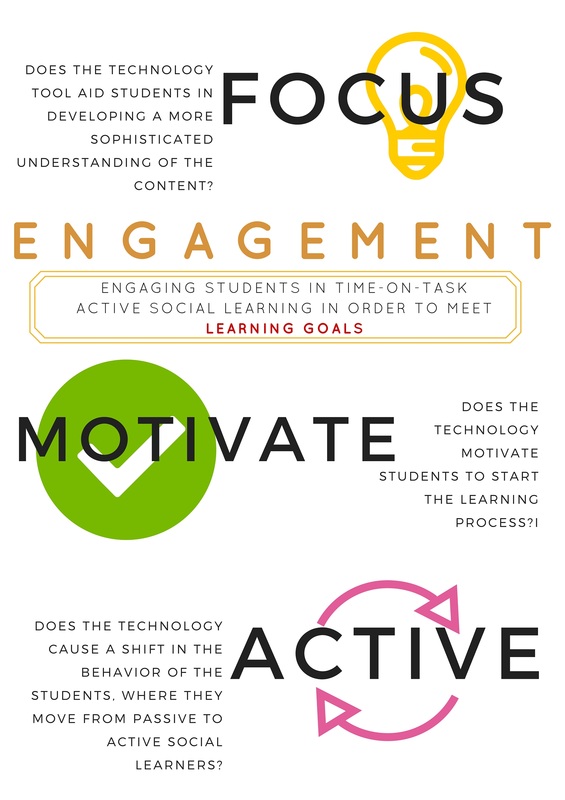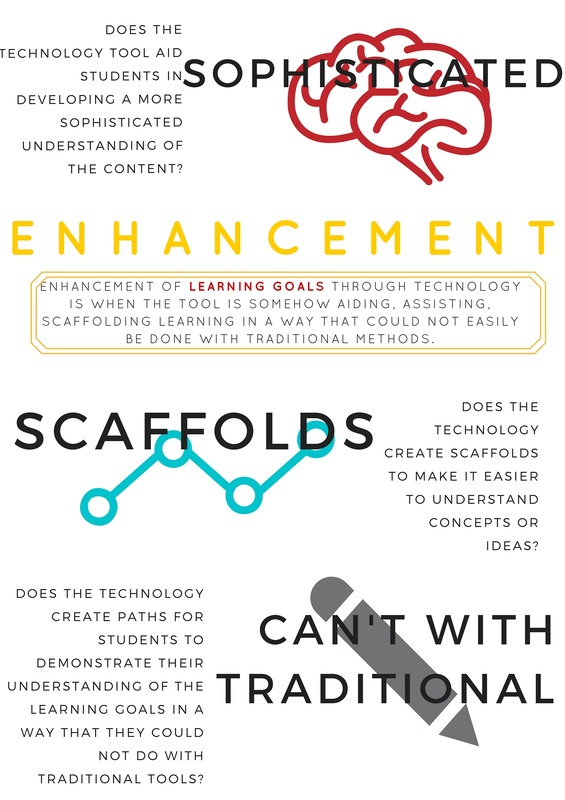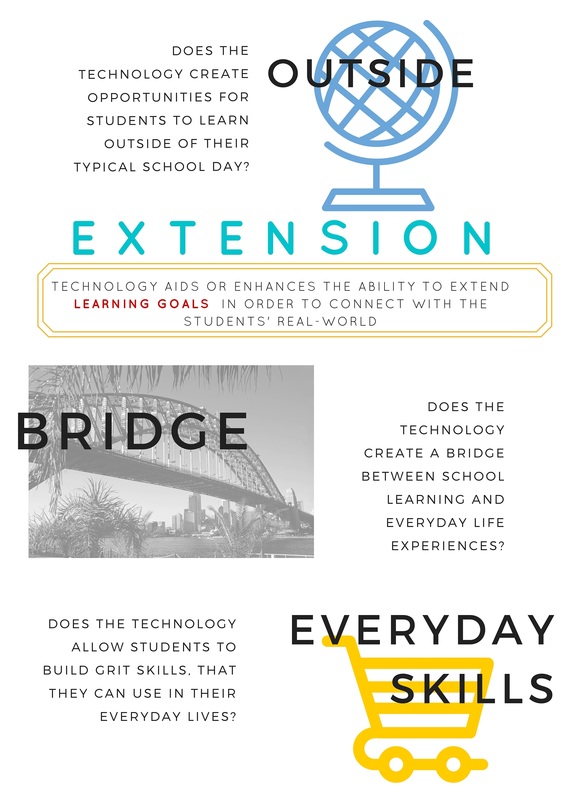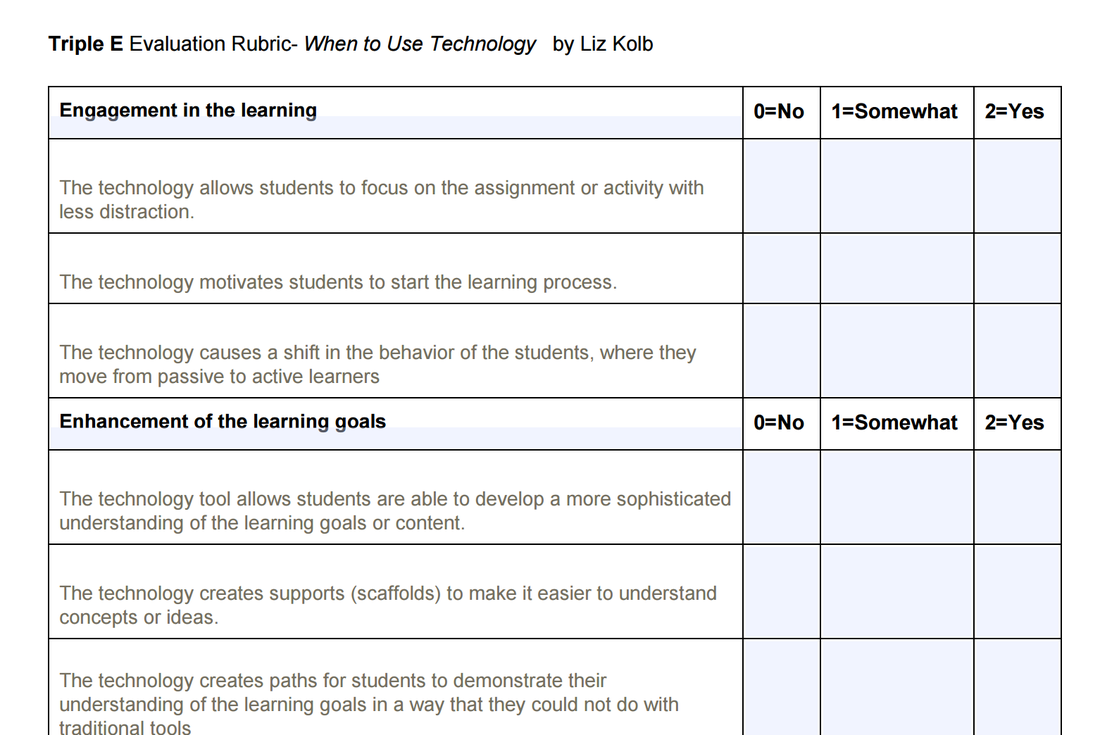EDU 807 Master - Week 2 - Triple E Framework - Summer 2018 - Group 1
1 Triple E Framework
2 About the Triple E Framework
3 Created by Dr. Liz Kolb, University of Michigan
4 http://www.tripleeframework.com/
|
6 What is the Triple E? 7 The Triple E Framework attempts to define what it should look like, sound like and feel like to integrate technology tools into teaching in order to meet and exceed learning goals. 8 The framework is based on three levels, Engagement in learning goals, Enhancementof learning goals, and Extension of learning goals. 9 While these terms are often used interchangeably, they are distinct and different. 10 The Triple E Framework defines each term and show examples of what makes each one unique and measurable.
11 The Triple E Framework is based on a considerable amount of research about what works and does not work when it comes to technology in learning. 12 In particular it emphasizes...
23 Read more about the research and links here
24 The Triple E Framework was developed in 2011 by Professor Liz Kolb at the University of Michigan, School of Education. The Triple E was created to fill a gap that has been pervasive in educational technologies---How to effectively integrate technology tools in K-12 learning so they have a positive impact on student achievement and learning outcomes.
25 WHY Triple E? The research on technology and learning over the past decade is fairly clear, technology should be integrated based on what we already know about good teaching and pedagogical practices. Dating back to the late 19th century, the foundation of current teaching practices is based on the work of pragmatism. Pragmatists like John Dewey (1897) pushed for learning to be embedded in the student's authentic everyday lives, socially constructed knowledge, active/hands-on learning and full of choice. Since the early 1990s Research has found that educational technology with a "drill and practice" approach often has no effects on learning or cognition. Yet, most technology tools created for education are still drill and practice and in the lower-order of Blooms Taxonomy.
26 Despite media often claiming a new piece of technology as a way to "revolutionize" learning, that is almost never the case. The Triple E framework takes this fallacy of technology as the magic bullet learning into account, and allows teachers to become critical consumers of making mindful choices around technology tools in their teaching. It is a simple framework, based on research, that helps educators create lessons that allow students to use technology to meet and add value to learning goals as active, social, creative learners, in authentic ways.
27
How Triple E is Different than other Tech Integration Models
28 Triple E Level 1: Engaged Learning
|










16 General Document comments
0 Sentence and Paragraph comments
0 Image and Video comments
General Document Comments 16


For this week, please look for a segment in each text where you can reply to the following:
What does this framework for using technology in education assume about teachers and teaching?
What does this framework for using technology in education assume about students and learning?
Please offer at least one comment related to the assumptions about teaching, as well as at least one comment on each document related to the assumptions about learning (2 initial comments). Then, please reply to at least two different classmates on one of their comments (2 responses).
New Conversation
Hide Full Comment Hide Thread Detail
The Triple E framework assumes that learning must be moving, deepening and relevant. These are the theories of our era…at least, they are the theories you read about in teacher education textbooks, in research, and at conferences. Reality in many classrooms may not be so compact or have the desired momentum. Some teachers just try to get through the day, just want their students to pass, just need to keep administrators happy. They have scripted curricula and creativity takes a back seat.
I do not like this reality. I, too, want education to move, be relevant, and to be deep. Our program here at CMU is certainly that way. Anything less would make me sleepy and perhaps resentful.
New Conversation
Hide Full Comment Hide Thread Detail
The further question, then, would be to consider whether or not we are fully meeting those goals, and, subsequently, actually using technology in the ways Dr. Kolb describes. I’ll be curious to hear your continually evolving thoughts on this matter.
New Conversation
Hide Full Comment Hide Thread Detail
We engage in conversation, in research, in exploring and application, in synthesis, and in creating new things (doing a webinar will be new for me!), all using technology. I’d say we are on track!
New Conversation
Hide Full Comment
Hi Susan,
I like that you said “learning must be moving, deepening, and relevant.” What a great way to put it! I feel like mainly the responsibility of this is the teachers to keep the students moving and deepen their understanding of topics. However, some of the responsibility falls on the students, as well. They have to have the desire and motivation to be able to deepen their own understanding and look for ways to make the topics relevant for themselves.
You are right that some teachers lack creativity and they just get through the day by doing the same old thing. I really do not get that. If a teacher is not excited about teaching than how can they expect the students to be excited about learning?
New Conversation
Hide Full Comment
Susan, I do think education is moving faster than we perceive it to be. The innovative programs available to students are exploding and EdTech is providing a pathway in some cases, causing educators to evaluate all of the archaic systems in place. In the past 5 years, our state has provided opportunity for schools to look at innovation and function outside of traditional school systems. It is exciting times!
New Conversation
Hide Full Comment Hide Thread Detail
Your experience with the exciting program in Michigan is inspiring. THEY are moving quickly. The rest of us can learn from them, catch up and keep up.
New Conversation
Hide Full Comment
I think that the framework for using technology in education assumes that the teacher understands how to use it correctly and better than the students. I feel like if, as a teacher, you are introducing new technology into the classroom, that you really have to know the ins and outs of the technology. If students cannot understand it quickly and pick it up easily, they are going to not want to do it. So, the explanation that the teacher provides is going to make-or-break the success of that technology.
New Conversation
Hide Full Comment Hide Thread Detail
When our college went to an ePortfolio (using ViaLiveText), we jumped in with very little training. The students learned it faster than we did and now teach each other. I was the faculty representative trying to get this momentum going, and I was the one who had a tiny bit of knowledge, so I also received the complaints from the students. That lasted a year. We’re fine now. I’m glad we made the move, even though I had to manage the grumbling. I learned alongside the students. I don’t recommend that process, but it worked for us.
New Conversation
Hide Full Comment Hide Thread Detail
I think that by not having proper training it puts unfair pressure on the teachers though. Also, on the students, if it is involving them. I realize that it works out over time, but it would take less time and teachers would be more efficient if proper training was involved.
Many of the schools in my area were getting grants for huge technology programs. However, once they got the equipment, the teachers were ill-prepared and did not understand what they were supposed to be doing. Most of them just did it the old way because that is what they were comfortable with.
New Conversation
Hide Full Comment Hide Thread Detail
Training is so important. And for some of us, it takes more than one afternoon of training to make it stick!
What I’m enjoying about the DET program is the focus on getting acquainted with the frameworks. That needs to be the first step…not a large grant and then equipment that sits there.
New Conversation
Hide Full Comment
I agree with you Michelle. It is so important to provide comprehensive training for teachers, yet the support throughout the first year of implementation is just as important. For the most part, teachers are extremely adaptable and part of the training must identify for them how tool will support learning for their students, and may aid with workload as well. Great point Michelle!
New Conversation
Hide Full Comment
I think that this framework assumes that students are going to be engaged in the new technology. It assumes that students do not want to do it the “old way” and that they are going to love it because it involves technology. I think that it, also, assumes that they are going to not dread working with the new technology and that it is going to be something that they want to do. Sometimes as adults, I feel like we get in this mode where just because it is techie we assume students will love it. That is definitely not the case. I even see this with my own kids, when I think they will really like something and they never use it. Students have to be able to apply what they are learning in technology outside of the classroom and use it to enhance their current practices, be more efficient at what they are doing, and help transform their way of thinking.
New Conversation
Hide Full Comment Hide Thread Detail
Thanks, Michelle, for raising this point about technology and motivation. This is definitely one of the contentions that Kolb is pushing upon, helping us think more clearly about what we mean when we say “engagement” and why we would want students to spend time using technology first place. I’ll be curious to learn more about the ways that you make these types of decisions for your own students in the lab.
New Conversation
Hide Full Comment
The triple E framework assumes teachers are grounded in good solid pedagogical practices, and the technology tools layer into those practices. It might take a newer teacher (within the first 3 years) some time to gain confidence in their craft before able to add meaningful technology tools to Engage, Enhance & Extend learning. There is an assumption teachers have the time to investigate and properly vet technological tools. With little time provided for PD altogether, mainly structured around state-mandated training, it is difficult from an administrative perspective to layer on the expectations of the deeper dive into technology integration. Guiding teachers through a purposeful process to utilize the Triple E framework, along with an identification of all the tech tools the district is able to provide (possibly creating a repository) would be quite the undertaking…but could be done through long range preparation and incorporating into the school improvement process.
For students, there is an assumption of access to the technology tools. Where engagement, enhancement and extension of learning not only captivates the student interest, but also available to them throughout the school day, and extended outside of the classroom. In many cases this is true, but not all students have 1:1 access, or the motivation. As educators, we need to continue to work on student access and interest-driven learning opportunities.
New Conversation
Hide Full Comment Hide Thread Detail
Teachers and students both need time for training. And, yes, state-mandated training takes a priority. Even in a private system, others are deciding what the PD plans will be. Teachers have to be motivated to learn technology on their own.
New Conversation
Hide Full Comment